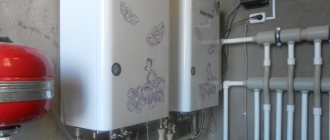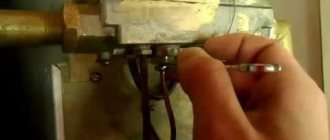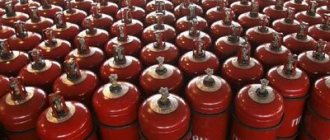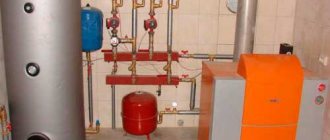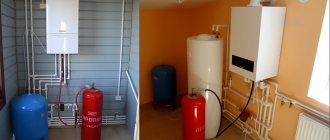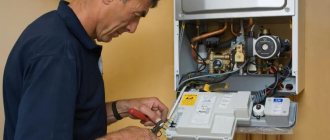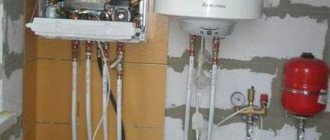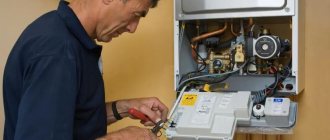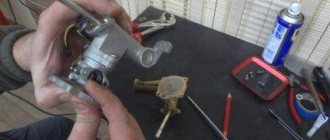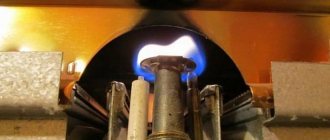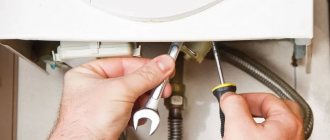Often water heaters are purchased for use at dachas, for work “in the field”. Accordingly, there may be no centralized gas supply in dacha cooperatives and villages. There is a way out - install an electric water heater or choose a gas water heater with the ability to connect to a cylinder. Can a gas water heater run from a gas cylinder? Yes, if the manufacturer has provided such an option. How to connect it and what fuel to use - you will find answers to these questions below.
You can also reconfigure an existing column. To do this, carefully read the instructions in the final part of the article.
Manufacturers
| Manufacturer | Characteristic |
| Vektor JSD 20-W (Russia) | Power - 20 kW. Water consumption when heating 25 °C - 10 l/min. Weight - 10.5 kg. Dimensions (H*W*D) - 580*330*208 mm. Automatic independent electric ignition, powered by batteries. To start, just open the mixer tap. Operates at water pressure from 0.2 to 7.5 atm. Multi-level security system. The automatic protection and safety system turns off the water heater when: - there is no sufficient draft in the chimney; — the flame on the burner goes out; - reducing water flow; - overheating of the heat exchanger. The presence of a digital display that displays the temperature of hot water at the outlet of the water heater. The presence of a “Winter-Summer” mode, which allows you to save gas up to 40% in the warm season. Instability of operation when water pressure changes, auto-ignition failures and heat exchanger leaks due to thin walls. The problem is likely to occur after a year of operation. Low price - about 4,500-4,800 rubles. |
| Neva 4510-M (Russia) | Affordable price and excellent functionality. Work on natural and liquefied gas. Power - 17.9 kW. Productivity - 10 l/min. Possibility of connecting several points of consumption. Bottom gas supply. Quiet operation. The presence of a thermometer and electric ignition on batteries. Works at a water pressure of 0.1 atm. There are problems with the quality of materials used and reliability. |
| Bosch WR 10-2P (Germany) | Power - 17.4 kW. Productivity - 10 l/min. Heating water up to 60 °C. Convenient mechanical rotary switches for temperature adjustment. Two versions of the dispenser are available - P23 for natural gas and P31 for liquefied gas from a cylinder. Work at pressure from 0.1 to 12 atm. The combustion chamber is open type, requiring the installation of an air vent. Easy to operate and install, small dimensions, quiet operation. Installation is vertical, on the wall. Bottom gas supply. Presence of piezo ignition. Thermometer for monitoring water temperature. The model is sensitive to water quality. Relatively high price. |
| Electrolux GWH 265 ERN Nano Plus (Sweden) | Power - 20 kW. Capacity is 10 l/min, which allows you to shower comfortably. Average cost of the model. Work at water pressure from 0.15 to 10 atm. Convenient controls. Installation - vertical, on the wall. Communications connections are from below. Availability of electric ignition. The presence of a “gas control” function that prevents any leakage of flammable substances. Fine temperature regulation and high sensitivity to pressure. |
As a result, the operation of an instantaneous water heater using liquefied gas will allow you to autonomously supply your house or cottage with hot water.
"Neva"
Water heaters "Neva" are products of OJSC Gazapparat. They are simple, reliable, economical and have low fuel consumption. Affordable. You can always find the necessary spare parts.
"Neva" 6011
Propane flow column. Estimated cost - 12,500 rubles. The modification is equipped with an automatic temperature control function with an accuracy of 1°C. There is a digital panel, mechanical buttons. The temperature is shown on the screen. Fault codes are also displayed here - there is self-diagnosis. Reliable protection against emergency situations. Technical features and parameters:
| Capacity, l/min | 11 |
| Nominal thermal performance, kW | 21 |
| Natural gas consumption, m³/h | 2,2 |
| Weight, kg | 10,4 |
| Minimum water pressure, bar | 0,15 |
| Dimensions (HxWxD), mm | 565x290x221 |
- auto ignition;
- open firebox with water cooling;
- no control panel provided;
- productivity - 11 l/min.
"Neva" 4510
Small 17 kW heater. Designed for 2 water intake points. For control - an electronic system. There is auto-ignition and indication. Weighs 10 kg. There is no constant burning pilot light - this is a plus.
| Capacity, l/min | 10 |
| Nominal thermal performance, kW | 17 |
| Natural gas consumption, m³/h | 1,95 |
| Liquefied gas consumption, kg/hour | 0,77 |
| Weight, kg | 10 |
| Minimum water pressure, bar | 0,15 |
| Dimensions (HxWxD), mm | 356x624x186 |
"Neva" 4511
Cost - 9,500 rubles. Wall option. Indicators - inclusion and pressure. Automatic ignition and open firebox. Characteristics:
| Capacity, l/min | 11 |
| Nominal thermal performance, kW | 21 |
| Natural gas consumption, m³/h | 2,2 |
| Liquefied gas consumption, kg/hour | 0,8 |
| Weight, kg | 11 |
| Minimum water pressure, bar | 0,15 |
| Dimensions (HxWxD), mm | 290x565x221 |
Connecting equipment to the cylinder
Before you start connecting the equipment yourself, make sure that the model is really suitable.
Other brands of acceptable equipment: , (almost all the latest models). The instructions for the Bosch speakers indicate that a 50-liter cylinder will be enough for 10 hours of stable operation at a power of 25 kW. A conversion kit for Bosch speakers can be purchased from an authorized service center.
If it is necessary to carry out work on reconfiguring equipment, replacing collector nozzles and assessing the tightness of joints, they must be done strictly according to the rules. The nozzles must be smaller in diameter: as in gas stoves, the pressure produced by liquefied gas reducers is 2–3 times higher than when natural gas is supplied through pipes. At the same time, the calorific value of liquid fuel is 1.5 times greater than that of natural gas.
The equipment must be marked with a refurbishment date - day, month and year. The type of gas suitable for use is also indicated.
The connection diagram of the cylinder to the main valve requires it to have a reducer with pressure stabilization of 300 mm of water. Art. and a minimum steam phase productivity of one cubic meter per hour.
Parameters of the hose connecting gas equipment to the fuel tank:
- 250 cm - minimum length;
- 1.2 cm is the least permissible inner diameter of the tube.
Please note that on online forums there is information of the following nature: if you reconfigure the column correctly and carry out the work without flaws, problems with water pressure may arise and the column will not start. Then you will need to additionally install a pressure pump
When installing a shut-off valve, remember that it must be easy to access so that in the event of an emergency the user can quickly turn it off.
After completing the installation work, check the tightness of the connections and conduct a test run of the equipment.
Instructions. Conversion of the Neva 4511 gas water heater to liquefied gas
The gas column has jets with a diameter of 1.28 mm. This set of nozzles is installed in the burner ramp for operation on natural gas with a pressure of 130 mm. water Art. (130 mbar). The ramp at the Neva 4511 gas water heater is ten-sectional, i.e. The ramp includes 10 nozzles.
The set of liquefied gas nozzles we offer contains 10 nozzles with a diameter of 0.75 mm.
The offered kit is only suitable for this model,
because, for example, the Neva 4510 gas water heater has a ramp that is simply of a different design. Moreover, this model of Neva 4511 has been studied quite well by us. It is easy to install, repair and maintain. When converted to liquefied gas, the dispenser consumes about a kilogram of gas per hour of operation. Now you will see for yourself that altering the ramp will not take much time. To move the column we need a Phillips screwdriver and an adjustable wrench (38 mm). The column itself does not need to be dismantled at all.
Begin
First you need to separate the ramp. An ignition electrode (candle) and a flame presence (ionization) sensor are attached to the ramp. Separate them by unscrewing two screws.
In the photo they are indicated by number No. 1. After separating the sensor and spark plug from the ramp, you need to remove four self-tapping screws (No. 2), which secure the burner ramp.
After separating them, take an adjustable wrench and unscrew the ramp nut from the gas column assembly.
The ramp is in our hands. After the ramp is in our hands, it is best to turn out the jets with a 7 mm socket so as not to damage the splines when tightening the new nozzles with pliers or an open-end wrench (the wrench is the same as the 7 mm socket). As you can see, replacing the nozzles requires almost nothing from your brain.
Now we will understand the principle of operation of an instantaneous gas water heater using liquefied gas (also known as bottled gas). Let's see what advantages such boilers have and how to install them (install). Finally, let's look at the rating of manufacturers who produce the best models on the market.
You can find out the price and buy heating equipment and related products from us. Write, call and come to one of the stores in your city. Delivery throughout the Russian Federation and CIS countries.
Owners of private houses and summer cottages are constantly selecting the best option for supplying users with hot water. One such option is an instantaneous water heater operating on.
Instantaneous water heater Vektor JSD
How to convert a heating boiler to liquefied gas
The main difference between natural gas and liquefied gas is that the former is supplied and burned at a higher pressure. The automation of conventional equipment is configured for indicators equal to 6-12 atm. When the readings drop, the pressure sensor is triggered, turning off the burner.
Operating a heating boiler using a propane-butane mixture requires changing the configuration and parameters:
- It is necessary to change the supply speed of the gas-air mixture.
- You will need to install a set of liquefied gas jets.
- Configure automation for other operating parameters.
Modern single-circuit and double-circuit heating boilers are designed to operate on liquefied and main gas. Conversion requires replacing the nozzles and switching the boiler to another mode.
The technical conditions for the use of liquefied gas in individual boilers not intended for this type of fuel differ significantly. In addition to replacing the jets, complex reconfiguration of the automation and control valves will be required.
It is difficult to correctly regulate the gas supply to the boiler when switching to liquefied gas, set the minimum pressure limit and perform other work independently, without special skills. According to current regulations, all work must be performed exclusively by licensed specialists.
The technical documentation of heating equipment indicates the minimum pressure at which the burner continues to operate. The lower this indicator, the more propane-butane mixture it will be possible to use from a filled fuel tank. Typically, 15-30% of the total volume remains in the container.
Nozzles for boilers for liquefied gas
In the section on how to convert a heating boiler to the flow rate of a gas boiler running on liquefied gas, the need to replace nozzles or nozzles was mentioned. Re-equipment is required for several reasons:
- The difference between nozzles for liquefied and main gas is the different diameters of the outlet. As a rule, jets for a propane-butane mixture are narrower.
- After installing a set of nozzles to convert the heating boiler from natural gas to liquefied gas, the pressure in the system increases slightly.
- The reduced diameter of the nozzle leads to a decrease in the flow rate of the gas-air propane-butane mixture. For normal operation of a 10 kW unit, the pressure is required to be no more than 0.86 kg/hour.
Injectors or jets are sold in sets. Some manufacturers include in the basic package all the fittings necessary for conversion. In other cases, the kit will have to be purchased separately.
What is the liquefied gas consumption of the boiler?
The volume of liquefied gas consumption in gas heating boilers is indicated in the technical documentation provided by the manufacturer. It is different for all models and depends on several factors:
- Performance.
- Burner type.
- Equipment setup.
The technical characteristics of liquefied gas consumption are also affected by how suitable the selected model is for a given type of fuel. On average, for a 10-15 kW unit, you will need 2 cylinders per week and per month.
Which gas is more profitable to heat - natural or liquefied?
Comparative consumption of natural and liquefied gas when operating a heating boiler shows that it is more profitable to heat a house when boiler equipment is connected to the main line. Heating with a propane-butane mixture should only be used in the following cases:
- Changes in the design and reconfiguration of the boiler when using liquefied gas are temporary. From the start of registration and ordering of a project for the installation of heating equipment connected to the main gas pipeline, it may take about six months. During this period, it is not economically feasible to heat the premises with electric or solid fuel heating equipment specially purchased for this purpose. The cost of converting a conventional boiler to liquefied gas ranges from 500-1000 rubles.
- Connecting a gas holder - in this case, the cost of using the mixture is more profitable than heating with wood, electricity or diesel fuel. The only condition is that a qualified specialist must adjust the pressure of liquefied gas and regulate the operation of the automation. Incorrect settings lead to an increase in consumption by approximately 15%.
The economic component, operational safety, the possibility of switching back to natural gas - all these factors make it advisable to use boilers running on liquefied gas.
Are there turbocharged models?
To heat water, you can use a turbocharged water heater. Such devices do not require a traditional vertical chimney; combustion products are discharged through a coaxial pipe led through the wall. It also supplies air to the closed firebox to maintain the combustion process. Turbocharged speakers have disadvantages: you need to make a hole in the pipe, ask the consent of neighbors above to install the equipment, the device is noisy due to the operation of the turbine. Plus, when working on propane-butane, you will also need to place a cylinder in the room. An important advantage of turbocharged versions is versatility; they can be placed in any room, since a chimney is not needed
The second important advantage is that they do not “eat up” the home air.
Gas consumption
The average user is interested in how much fuel his dispenser consumes. If the device operates from a centralized gas supply, you need to know how many cubic meters are consumed per unit of time; If it's propane, I wonder how long one tank will last? Costs depend on various characteristics and, above all, on thermal power. An example of calculating propane-butane consumption. Initial data:
- specific heat of combustion - 14 kW/h;
- Efficiency - about 92%;
- burning 1 kg of propane-butane mixture gives 12.9 kW/h.
Let us have a heater that produces 5 liters of hot water per minute, and fuel consumption is 1.5 kg per hour. A 50 liter cylinder contains 42 liters or 23 kg of propane-butane. By making simple mathematical calculations, you can find out that one cylinder is enough to heat 4,600 liters of water. Translated into hours, this is a little over 15 hours of continuous heating. If you use hot water for 2 hours a day, you will need 4 cylinders per month.
What volume of gas cylinder to choose
Based solely on current propane costs, it will be enough to install one 50 liter cylinder. Even with uneconomical consumption of liquefied gas, the fuel should last for 10-15 days. And this is assuming a large family of 4-5 people. The technical data sheet for water heaters states that a 50 liter gas cylinder is enough for 10-12 hours of continuous operation.
Experts recommend connecting a propane dispenser through a ramp. Thus, it is possible to reduce the load when operating a gas water heater from one to several gas cylinders, evenly distributing fuel consumption and preventing freezing of the walls and reducer. Connection via a ramp allows you to install several smaller containers of 25/40 liters each. Or, as an option, use 50 liter cylinders connected in conjunction with each other.
How to choose
Instantaneous water heaters operating on gas - natural or liquefied - have almost the same design. Differences in nuances - materials, control method, degree of automation. Important parameters when choosing a gas water heater:
- Ignition method. Older versions were lit by hand using matches and lighters. Today, manufacturers offer three ignition options - piezo, electric and from a hydrogenerator.
- Heat exchanger material. The service life of the device depends on the quality of this part. If you buy a cheap Chinese device, the heat exchanger in it may turn out to be tin. Such water heaters do not last longer than three years.
- The inner diameter of the tubes in the heat exchanger. Wide tubes do not need to be descaled as often as narrow tubes.
- Water block. Metal is preferable. A cheaper alternative is plastic.
- Performance. When choosing this parameter, you need to take into account the volume of water flowing from the tap per unit time. The easiest way is to note the time and look at the result on the water meter. If the flow is less than 10 l/min, why buy a model with a capacity of 15 or more l/min?
- Temperature control - manual or automatic. The first ones are cheaper. The adjustment is made by valves. In versions with power modulation, the temperature is maintained at a given level automatically.
- Removal of combustion products. It is safer to output through a coaxial chimney. Along with the power of the device, the diameter of the pipe increases. The second option is output through a traditional chimney. The third one has no chimney. The latter cannot be installed in a confined space and without ventilation. These are usually mini-speakers - devices with low power.
- Oxygen supply. In cheap versions, air is supplied through vents. Minus - combustion products penetrate back into the room. Expensive devices are equipped with a pipe leading from the bottom of the device. The housing is additionally closed with lids - from below and from above, so that combustion products do not penetrate into the room.
- Power. Mini-heaters of 17–19 kW are suitable for systems with low pressure and one water intake point. Powerful devices should be taken for a pressure of more than 10 l/min and with several water intake points. Versions for 21–31 kW are not installed in apartments, these are options for country houses.
Main characteristics of the speakers
Now let's talk about the practical aspects of using the speaker. One of the main characteristics is performance. It directly correlates with power, which is indicated in kW and shows the volume of water heated per minute by 25 °C.
The characteristics are usually indicated in the device passport. A regular water heater heats 10-20 liters of water per minute at 25 °C, although this value can vary significantly.
Another characteristic of modern speakers is power modulation. It shows how the power of the column can change depending on the flow of water and is measured as a percentage of the initial power.
For modulation, the columns are equipped with special fittings with a membrane, which changes the gas supply to the burner depending on the flow. Modulation in the range of 40-100% of the device power is considered normal.
Switching to alternative fuel
Most dispensers can be converted to an alternative type of gas - from natural to liquefied and vice versa. The changeover must be carried out by a service department that has the appropriate certificate. You must use parts kits from the manufacturer. When reconfiguring, the manifold jets are replaced: you need to install nozzles with a diameter suitable for the type of fuel used and its pressure. When performing work, turn off the device and turn off the gas valve. After completion of work, check the tightness of the connections. On the device itself and in its instructions it is written what it is used for, the date of completion of the work, and the organization of the performer of the work.
Advantages
Pros of propane water heaters:
- efficiency - cheap fuel and low cost of equipment;
- high efficiency value of the heat exchanger - reaches 88%;
- a hydraulic gas burner device is used that regulates the supply of propane - it reacts to changes in pressure;
- you can choose a modification that suits your specific requirements - a wide range of models is offered.
Vector
"" - budget speakers assembled from Chinese components. Many consider them to be a thing of the past, but our consumers value them for their simplicity and low cost - the model range consists of devices whose price does not exceed 4,000 rubles.
Despite its cheapness, this equipment works properly, providing homes and apartments with hot water. All models have a stylish design; they can even become a decorative element. A distinctive feature is compactness. Chinese spare parts, if necessary, are easy to find in any market.
Controls - knobs for adjusting the gas and water passing through the heat exchanger. Some versions are equipped with a mode switch - winter and summer. The disadvantage is accelerated wear of spare parts. For example, the walls of the heat exchanger are made of copper, but this layer is so thin that they fade over time. There is no flame control module.
Vector JSD 20
Like all representatives of the Vector model range, the speaker is cheap - it costs about 4,000 rubles. Compact, fits in the cramped kitchen. There is a digital display and auto ignition. Color - white, gold and silver. Closed chamber. Electric ignition.
Vektor JSD 11-N
Compact version for small spaces. There is an automatic fire extinguishing sensor and overheating protection. Heats up 5 l/min. It weighs only 4.5 kg, but is designed for only one water intake point. Options:
Vektor Lux Eco 20-3
This new product from Vector has improved protection that reduces the risk of overheating. The closed firebox is cooled with water. Selecting and setting the temperature mode. There is a digital display. Case with mirror panel. The model was developed taking into account changes in pressure in water pipes. The average cost is 8,000 rubles.
Now we will understand the principle of operation of an instantaneous gas water heater using liquefied gas (also known as bottled gas). Let's see what advantages such boilers have and how to install them (install). Finally, let's look at the rating of manufacturers who produce the best models on the market.
You can find out the price and buy heating equipment and related products from us. Write, call and come to one of the stores in your city. Delivery throughout the Russian Federation and CIS countries.
Owners of private houses and summer cottages are constantly selecting the best option for supplying users with hot water. One such option is an instantaneous water heater operating on.
Instantaneous water heater Vektor JSD
Principle of operation
The main function of geysers is to heat water in the shortest possible time. It looks like a housing in which the combustion chamber is located.
In a column powered by liquefied gas, water is heated as it flows through a heat exchanger, which in turn is heated by the burner. In addition, the device contains such elements as: a water cooling system, a control unit, temperature, pressure and draft sensors. Thanks to the electronic security system, the operation of the column is monitored throughout its entire operation.
Water heater Electrolux GWH 265 ERN NanoPlus
The best storage gas water heaters
Such devices have a capacious body with an internal tank. The latter is equipped with a heating element heated by a flame from a gas burner.
The device operates without a network connection. Some models also operate on liquefied gas. Thermal insulation of the housing ensures that the temperature of the heated liquid is maintained.
Ariston SGA 200 R - with a huge tank
This is the best gas storage water heater for a large family or for arranging a shower in the gym, in a locker room at work, because the tank capacity is 195 liters. At the bottom of the structure there is a small combustion chamber with a submersible heating element and controls.
Due to its large weight and size, the boiler is installed on the floor, and the water inlet and outlet connections, as well as the smoke removal channel, are located on top.
Pros:
- The heating time of the huge container is only 75 minutes;
- you can connect up to 5 taps;
- simple floor installation with top connection;
- heats water to a temperature of 75 degrees;
- operates from a minimum system pressure of 0.2 bar;
- the inside surface of the tank is covered with enamel;
- the tank is insulated with polyurethane foam;
- in the upper part of the case, a dial thermometer always reports the temperature;
- ignition of the burner by a piezoelectric element;
- control of gas flow without flame;
- the anode is made of an anti-corrosion alloy and coated with magnesium;
- gas valve with three safety stages;
- steel body;
- work indicator;
- there is a drain valve;
- capable of running on liquefied gas.
Minuses:
- cost from 43,000 rubles;
- large sizes 50x35x170 cm are more difficult to place;
- 1 year warranty;
- the adjustment is located at the bottom, so you have to bend down every time to change the settings;
- There is no overheating protection.
READ ALSO
5 best Thermex water heaters
Geysers powered by gas cylinders
If there is no centralized gas supply, you have to heat water and cook food using gas water heaters and stoves that can run on a gas cylinder.
The gas cylinder used to heat water contains gases such as propane and butane. They are by-products of oil, gasoline and gas refining. The cylinders may contain only technical butane or a mixture of butane and propane, which is available in summer and winter.
Compression of these gases converts them into a liquid of a smaller volume (and therefore such a gas is called liquefied), and as the pressure decreases, this liquid begins to turn into a vapor state. Since an increase in temperature causes a strong expansion of liquefied gases, the cylinder is usually filled to 85% of its volume, so there is always a layer of vapor gas above the liquid gases.
For a dacha, choosing a heater that uses gas from a cylinder as an energy source is often the only way to get hot water in a dacha. In situations where there is no main gas pipeline connected to the dacha, and there are also problems with the electrical network, a gas water heater of this type will be a real salvation.
When operating a water heater connected to a gas cylinder, on average one gas cylinder with a capacity of 50 liters is enough to provide the minimum daily hot water for two to three people for a month.
First of all, you need to make sure that your gas water heater is configured to use the gas that is present in the cylinder. If required, work is carried out to re-adjust the column by replacing the collector nozzles and assessing the tightness of the connections. In this case, the equipment must be marked with the date of reconfiguration and the type of gas that can be used in the device.
The cylinder that will be connected to the gas water heater must be equipped with a reducer with a stabilization pressure of 300 mm water column, as well as a minimum vapor phase capacity of 1 m³ per hour
They also pay attention to the selection of the hose - its length should be up to two and a half meters, and the internal diameter should be from 12 millimeters
It is important to purchase a hose that can withstand working with a gas cylinder dispenser.
When installing the hose, do not bend or twist it. If the hose has to be installed with a bend, adapters are used for this and the radius of the bend is monitored (it should not be less than 90 mm along its outer line). In addition, the hose must not bend within 50 mm of the ends of the nozzles.
The installation of a gas shut-off valve must be carried out in front of the column so that this valve can be easily reached. After completion of installation work, the hose and other connections should be checked to ensure that leaks are detected in a timely manner. Only after this can the column be used to heat water.
www.o-vannoy.ru
Installation
Before installing a gas instantaneous water heater using liquefied gas, you need to understand the cylinder. It is important that it meets the following characteristics:
- There must be a gearbox on it.
- Pressure equal to 300 mm. water Art.
- The minimum capacity of the first phase of the cylinder should be 1 m³ per hour.
It is also necessary to purchase a flexible hose with an internal diameter of at least 12 mm and a length of no more than 2.5 m. This hose must withstand the gas, taking into account the required temperature and required pressure.
A gas shut-off valve must be installed in front of the column itself. After you complete the installation, be sure to check all connections and the hose so that if there are any problems, they can be corrected immediately.
If you have experience working with gas equipment, then you can install the gas water heater yourself. If not, you should contact a specialist.
